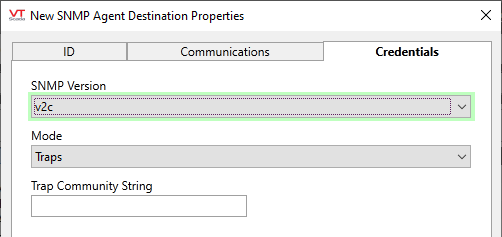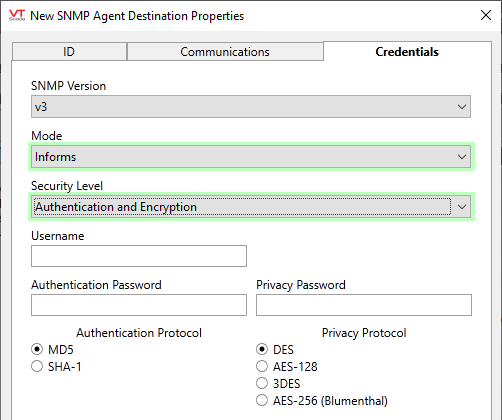SNMP Agent Destination Tag
This tag is used to specify destination SNMP entities for the traps and informs outgoing from VTScada SNMP agent. If the application property "SNMPAgentPublish" is set, then every IO tag (or legacy io) that has the publish flag set, will be published via SNMP trap/inform to all the destinations in the destination tags.
A VTScada SNMP Agent operating in v2c can use either this tag or the legacy application properties, SNMPAgentTagNotifyMode,SNMPAgentTrapCommunity, SNMPAgentTrapHost, SNMPAgentTrapPort.
For communication in SNMP v3, an SNMP Agent Destination tag must be used to send traps or informs.
The ID tab of every tag includes the same common elements: Name, Area, Description, and Help ID.
Name:
Uniquely identifies each tag in the application. If the tag is a child of another, the parent names will be displayed in a separate area before the name field.
You may right-click on the tag's name to add or remove a conditional start expression.
Area
The area field is used to group similar tags together. By defining an area, you make it possible to:
- Filter for particular tag groups when searching in the tag browser
- Link dial-out alarm rosters to Alarm tags having a particular area
- Limit the number of tags loaded upon startup.
- Filter the alarm display to show only certain areas.
- Filter tag selection by area when building reports
When working with Parent-Child tag structures, the area property of all child tags will automatically match the configured area of a parent. Naturally, you can change any tag's area as required. In the case of a child tag, the field background will turn yellow to indicate that you have applied an override. (Orange in the case of user-defined types. Refer to Configuration Field Colors)
To use the area field effectively, you might consider setting the same Area for each I/O driver and its related I/O tags to group all the tags representing the equipment processes installed at each I/O device. You might also consider naming the Area property for the physical location of the tag (i.e. a station or name of a landmark near the location of the I/O device). For serial port or Roster tags, you might configure the Area property according to the purpose of each tag, such as System or Communications.
You may define as many areas as you wish and you may leave the area blank for some tags (note that for Modem tags that are to be used with the Alarm Notification System, it is actually required that the area field be left blank).
To define a new area, type the name in the field. It will immediately be added. To use an existing area, use the drop-down list feature. Re-typing an existing area name is not recommended since a typo or misspelling will result in a second area being created.
There is no tool to remove an area name from VTScada since such a tool is unnecessary. An area definition will exist as long as any tag uses it and will stop existing when no tag uses it (following the next re-start).
Description
Tag names tend to be brief. The description field provides a way to give each tag a human-friendly note describing its purpose. While not mandatory, the description is highly recommended.
Tag descriptions are displayed in the tag browser, in the list of tags to be selected for a report and also on-screen when the operator holds the pointer over the tag’s widget. For installations that use the Alarm Notification System, the description will be spoken when identifying the tag that caused the alarm.
The description field will store up to 65,500 characters, but this will exceed the practical limits of what can be displayed on-screen.
This note is relevant only to those with a multilingual user interface:
When editing any textual parameter (description, area, engineering units...) always work in the phrase editor. Any changes made directly to the textual parameter will result in a new phrase being created rather than the existing phrase being changed.
In a unilingual application this makes no difference, but in a multilingual application it is regarded as poor practice.
Help Search Key
Used only by those who have created their own CHM-format context sensitive help files to accompany their application.
SNMP Agent Destination properties, Communications tab
This tab identifies the remote SNMP entity to which the outgoing SNMP notifications (TRAPS or INFORMS) are destined.

Address
Name or IP address of the remote system
Port
Port number for the remote system
SNMP Agent Destination properties, Credentials tab
Varies according to whether the SNMP version is set to v2c or v3.


SNMP Version
Select either v2c or v3. This choice affects the remaining properties.
Mode
Chose between Traps and Informs.
(v2c) Trap Community String
The SNMP trap community string to be used.
(v3) Security Level
Choose between None, Authentication Only, or Authentication and Encryption.
(v3) Username
Username for the SNMP credentials
(v3) Authentication Password
Security level must be set to at least Authentication.
Provide the authentication password. This is encrypted before being stored and will never be displayed as readable text. After the cursor leaves this configuration field, changes can be made only be clearing the field and entering a new value.
(v3) Authentication Protocol
Security level must be set to at least Authentication.
Specifies the authentication protocol in use for the given username. May be either MD5 or SHA-1
(v3) Privacy Password
Security level must be set to at Authentication and Encryption.
Encrypted privacy password. This will never be displayed as readable text. After the cursor leaves this configuration field, changes can be made only be clearing the field and entering a new value.
(v3) Privacy Protocol
Security level must be set to at Authentication and Encryption.
Specifies the privacy protocol in use for the given username. May be any of DES, AES-128, 3DES or AES-256.
The following widgets are available to display information about your tags:
